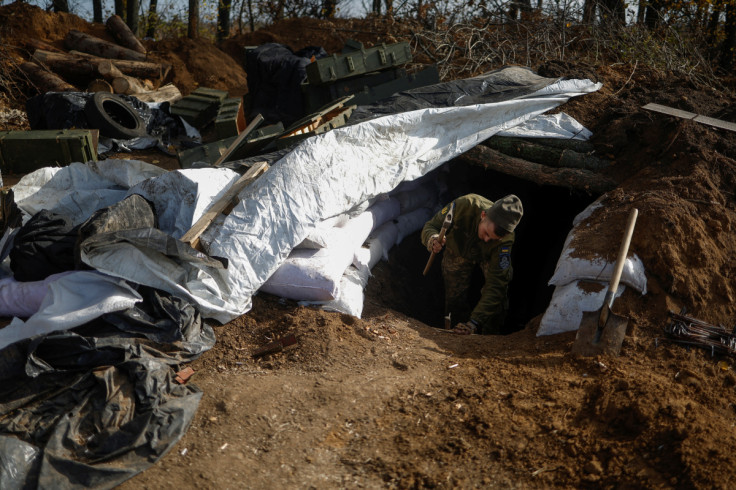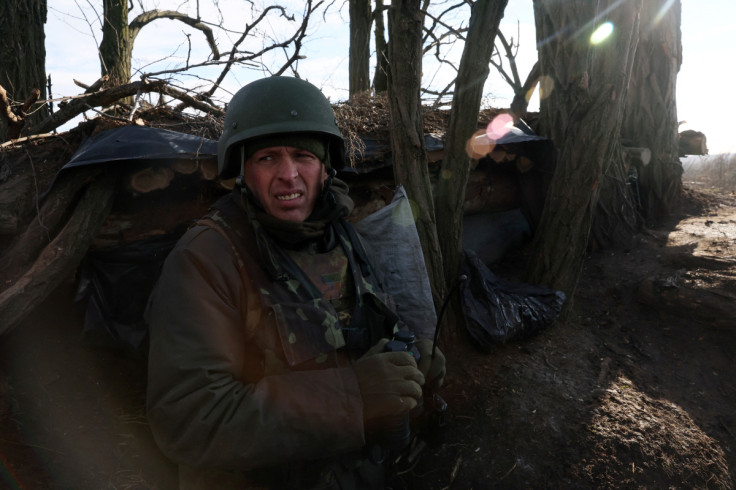Ukrainian Soldiers Face A New Adversary: Muddy Trenches

Squelching through thick mud on Tuesday, Petro, a Ukrainian soldier dug in not far from Russian positions in the Donbas, recounted matter-of-factly how his unit had to use buckets to clear out water-logged trenches.
"We're more or less okay, but it's bit harder now because of the rain and a light frost. It's a swamp. It's dried a bit today...," the 35-year-old said, warming up in a dugout near the trenches.
"It's okay, we're holding up," he added, laughing.
Heavy rain and falling temperatures are making conditions even grimmer along the frontlines, where tens of thousands of Ukrainians and Russians are facing off as the war, now in its 10th month, grinds into winter.
Buoyed by the recapture of the southern city of Kherson from Russia this month, Ukraine wants to maintain the initiative on the battlefield even as deteriorating conditions make it harder to manoeuvre easily and for troops to keep warm.
At a location in the southern part of the Donbas in southeastern Ukraine, soldiers showed Reuters around muddy positions where they are living. The military said the exact location should not be disclosed.
Despite the heavy conditions, a Ukrainian tank was easily able to speed down a muddy track before opening fire on a Russian target.
The Donbas, a heavily industrialised region that is partially occupied by Moscow, comprises the Donetsk and Luhansk provinces that Kremlin leader Vladimir Putin has declared to be annexed, Russian land.
The region, which includes the destroyed Sea of Azov city of Mariupol and the smaller cities of Sievierodonetsk and Lysychank, has been the site of some of the fiercest fighting of the war.
BATTLEFIELD SLOWDOWN
Ukraine's Defence Minister Oleksii Reznikov told Reuters earlier this month that bad winter conditions would give both Kyiv and Moscow's forces a chance to recuperate.
"The winter will slow down every activity on the battlefield for all sides ... It's beneficial for all sides. You will have a rest," he said in an interview.
He predicted, though, that Ukraine would come out of the hiatus strong, reinforced by thousands of soldiers being trained in Britain.
Some military analysts said they expected Ukraine would try to keep up the pressure on Russian forces over the winter to prevent them digging in and settling.
The winter weather will likely favour the Ukrainian military, Jack Watling, an analyst at the London-based Royal United Services Institute, wrote on Twitter.
He said Ukrainian fighting positions tended to be well-kept, dry and warm, and soldiers had warm clothing.
Newly-mobilised Russians, by contrast, did not have the experience or skills to operate for long periods in the field and had not been issued with winter clothing for the most part, Watling said.
NATO chief Jens Stoltenberg called on member allies to pledge more winter aid for Kyiv at a meeting of the military alliance in Bucharest.
(Writing by Tom Balmforth; editing by Alex Richardson)


© Copyright Thomson Reuters 2025. All rights reserved.





















